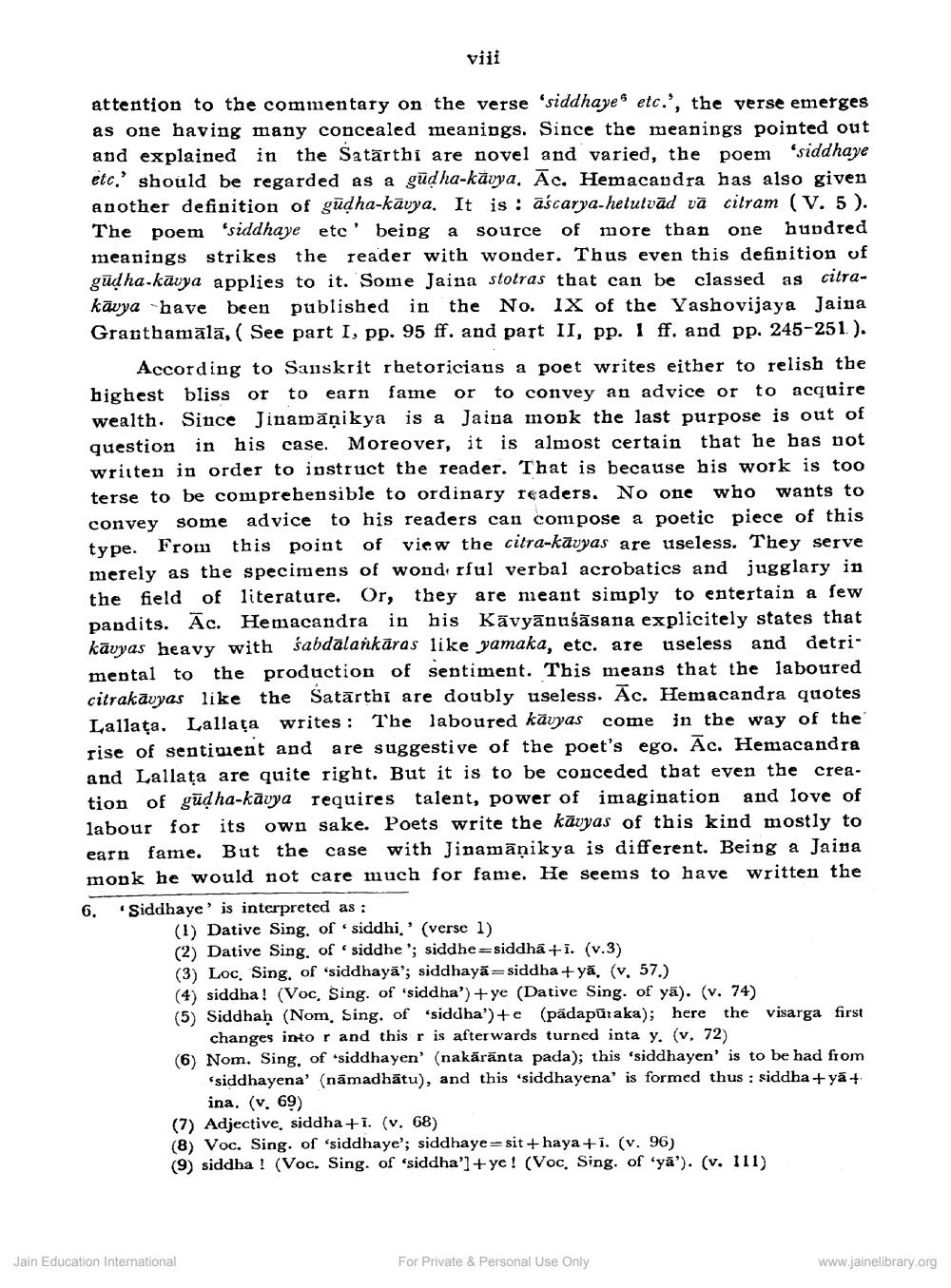________________
viii
attention to the commentary on the verse ‘siddhayes etc.', the verse emerges as one having many concealed meanings. Since the meanings pointed out and explained in the Satārthi are novel and varied, the poem 'siddhaye etc,' should be regarded as a gūdha-kävya. Āc. Hemacandra has also given another definition of gūdha-kavya. It is : ascarya-hetutvād vā cilram (V. 5).
The poem 'siddhaye etc' being a source of more than one hundred meanings strikes the reader with wonder. Thus even this definition of gūdha-kavya applies to it. Some Jaina stotras that can be classed as citrakāvya have been published in the No. IX of the Yashovijaya Jaina Granthamālā, ( See part I, pp. 95 ff. and part II, pp. I ff. and pp. 245-251).
According to Sanskrit rhetoricians a poet writes either to relish the highest bliss or to earn fame or to convey an advice or to acquire wealth. Since Jinamāņikya is a Jaina monk the last purpose is out of question in his case. Moreover, it is almost certain that he has not written in order to instruct the reader. That is because his work is too terse to be comprehensible to ordinary readers. No one who wants to convey some advice to his readers can compose a poetic piece of this type. From this point of view the citra-kavyas are useless. They serve merely as the specimens of wonderful verbal acrobatics and jugglary in the field of literature. Or, they are meant simply to entertain a few pandits. Ac. Hemacandra in his Kāvyānušāsana explicitely states that kavyas heavy with sabdalaňkāras like yamaka, etc. are useless and detrimental to the production of sentiment. This means that the laboured citrakāvyas like the Satārthi are doubly useless. Ac. Hemacandra quotes Lallaţa. Lallața writes : The laboured kävyas come in the way of the rise of sentiment and are suggestive of the poet's ego. Āc. Hemacandra and Lallața are quite right. But it is to be conceded that even the creation of gūdha-kavya requires talent, power of imagination and love of labour for its own sake. Poets write the kävyas of this kind mostly to earn fame. But the case with Jinamāņikya is different. Being a Jaina monk he would not care much for fame. He seems to have written the 6. "Siddhaye' is interpreted as:
(1) Dative Sing, of siddhi.' (verse 1) (2) Dative Sing. of siddhe '; siddhe=siddha + i. (v.3) (3) Loc. Sing, of 'siddhaya'; siddhayā=siddha+yä. (v. 57.) (4) siddha! (Voc, Sing. of 'siddha') +ye (Dative Sing. of yā). (v. 74) (5) Siddhaḥ (Nom. sing. of 'siddha')+e (pädapūraka); here the visarga first
changes into r and this r is afterwards turned inta y. (v. 72) (6) Nom. Sing. of siddhayen' (nakārānta pada); this 'siddhayen' is to be had from
siddhayena' (nāmadhātu), and this 'siddhayena' is formed thus : siddha+ya+
ina. (v. 69) (7) Adjective, siddha +i. (v. 68) (8) Voc. Sing of 'siddhaye'; siddhaye=sit+haya+i. (v. 96) (9) siddha ! (Voc. Sing. of 'siddha'] + ye ! (Voc, Sing. of 'ya'). (v. 111)
Jain Education International
For Private & Personal Use Only
www.jainelibrary.org




